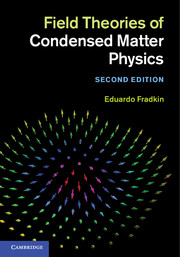Book contents
- Frontmatter
- Contents
- Preface to the second edition
- Preface to the first edition
- 1 Introduction
- 2 The Hubbard model
- 3 The magnetic instability of the Fermi system
- 4 The renormalization group and scaling
- 5 One-dimensional quantum antiferromagnets
- 6 The Luttinger liquid
- 7 Sigma models and topological terms
- 8 Spin-liquid states
- 9 Gauge theory, dimer models, and topological phases
- 10 Chiral spin states and anyons
- 11 Anyon superconductivity
- 12 Topology and the quantum Hall effect
- 13 The fractional quantum Hall effect
- 14 Topological fluids
- 15 Physics at the edge
- 16 Topological insulators
- 17 Quantum entanglement
- References
- Index
16 - Topological insulators
Published online by Cambridge University Press: 05 March 2013
- Frontmatter
- Contents
- Preface to the second edition
- Preface to the first edition
- 1 Introduction
- 2 The Hubbard model
- 3 The magnetic instability of the Fermi system
- 4 The renormalization group and scaling
- 5 One-dimensional quantum antiferromagnets
- 6 The Luttinger liquid
- 7 Sigma models and topological terms
- 8 Spin-liquid states
- 9 Gauge theory, dimer models, and topological phases
- 10 Chiral spin states and anyons
- 11 Anyon superconductivity
- 12 Topology and the quantum Hall effect
- 13 The fractional quantum Hall effect
- 14 Topological fluids
- 15 Physics at the edge
- 16 Topological insulators
- 17 Quantum entanglement
- References
- Index
Summary
Topological insulators and topological band structures
The term topological insulator refers to a novel (in 2011) class of solid-state systems that have quantized transport properties due to topological properties of their band structures. In this chapter I will provide a description of the salient ideas behind this new and rapidly growing field. I will certainly not attempt to be exhaustive in the presentation. Several specialized reviews have recently become available and the reader is referred to them for more details (including an extensive list of references) (Hasan and Kane 2010; Hasan and Moore, 2011).
What is a topological insulator? It is an electronic system that is an insulator but whose band structure is characterized by a topological invariant, i.e. a number that in general is quantized to be an integer. As such, states of this type are robust in the sense that their physical properties are stable (unchanged) under the action of local perturbations of finite size. From this definition it follows that the properties of topological insulators can be characterized at the level of free-fermion systems and are not necessarily the result of strong-correlation physics. They are a generalization of the conceptual framework behind the integer quantum Hall states. However, in spite of the topological properties of their band structures, the ground states of topological insulators are essentially unique and, even when degeneracies may be present, they do not depend on the topology of the space. Hence topological insulators are not topological fluids in the sense of the fractional quantum Hall states or of the deconfined gauge theories (and spin liquids). It is quite likely that, at least in two dimensions, there may exist topological fluids that are generalizations of topological insulators. At the time of writing this is an open area of research whose future is difficult to predict.
- Type
- Chapter
- Information
- Field Theories of Condensed Matter Physics , pp. 669 - 752Publisher: Cambridge University PressPrint publication year: 2013

